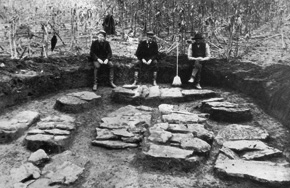FORT ANCIENT
FORT ANCIENT
HISTORIES
The Hopewell era earthen monument that rings the hilltop is only one phase of the uses and histories of this site.
Archaeologist Bob Connolly explains the long Native heritage here:
This plateau was actually used long before the construction of the Fort Ancient site, and after as well.
We find artifacts here that date to as early as 5000 years B.C. In addition, the later, so-called “Fort
Ancient Culture” occupied the South Fort around A. D. 1000 to 1200. What this points to is that this plateau
was an extremely important part of the built environment of the Native American cultures for a five to seven
thousand year period.
Around 1800, the first settlers quickly turned Fort Ancient into a tourist attraction. An early description was
published back in Philadelphia in 1809. Caleb Atwater described it in his 1820 publication on Ohio Antiquities,
earning praise from President Thomas Jefferson. An early highway cut through the northern section (State Route
350 today); and by the later 1800s, there was a railway stop and hotel at the bottom of the hill,
beside the river.
The preservation of Fort Ancient was assured after archaeologist Warren Moorehead convinced the Ohio
legislature to make it a State Memorial, in 1891. But it has seen many uses: while it was a World War I training
camp, the troops practiced “storming the walls.” That’s probably the nearest it ever came to being a real fort!
Today, in the valley below, a canoe livery and bike trail help attract visitors to this spot on the Little
Miami. In 2009, the Ohio Historical Society entered a partnership with the Dayton Society of Natural History
to manage the site.

Ohio Historical Society archaeologist Warren King Moorehead (left in this photo) conducted extensive excavations at Fort Ancient in the late 1800s.


